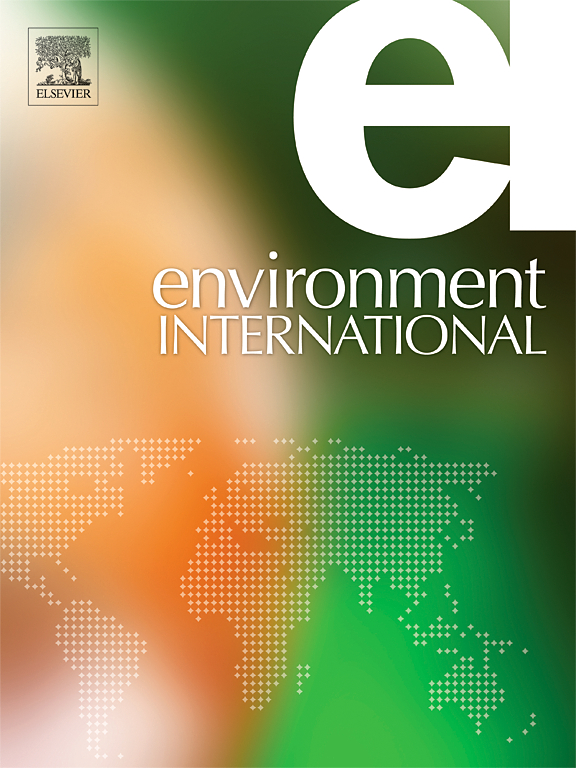Revisiting the association between transportation noise and heart disease reported in the World Health Organization Environmental Noise Guidelines for the European Region: a systematic review and meta-analysis
IF 10.3
1区 环境科学与生态学
Q1 ENVIRONMENTAL SCIENCES
引用次数: 0
Abstract
Background
Whilst the link between long-term exposure to transportation noise and cardiovascular disease has been discussed for several decades, there are still uncertainties in the exact quantitative relationship between the two. A systematic review and meta-analysis that informed recommendations in the World Health Organization Environmental Noise Guidelines for the European Region included studies published up to 2015. Since then, there has been a rapid increase in publications from epidemiological studies exploring the risk over a larger noise exposure range, and with more precise exposure assignment. Given the influential nature of the WHO Guidelines, we investigated whether the inclusion of studies published up to December 2023 changes the quantitative relationship.
Methods
We carried out a systematic review and meta-analysis on the association between transportation noise (road, rail, and aircraft) and heart disease, specifically ischaemic heart disease (ICD-10 I20-25), atrial fibrillation (ICD-10 I48) and heart failure (ICD-10 I50). We followed the same methodology (search terms, inclusion criteria, risk of bias evaluation and assessment of the quality of evidence) of the WHO systematic review. Pooled effect estimates were calculated for road, railway, aircraft and mixed noise sources using random effects models. For road traffic noise we investigated potential sources of between-study heterogeneity using meta-regression. We also explored the potential effect of noise exposure assignment precision on the effect estimates.
Results
Fifty-three studies were included in the systematic review: 85 % investigated associations for road, 23 % for rail and 30 % for aircraft noise exposure. The papers spanned 15 countries, with the majority (87 %) of studies investigating populations within European countries. In total 35 studies were included in the meta-analyses for heart disease incidence, 28 for mortality and five for prevalence. We found positive associations between long-term exposure to road traffic and aircraft noise and heart disease incidence (relative risk (RR) = 1.02 [95 % confidence interval (CI),1.01 to 1.04]; RR = 1.03 [0.99 to 1.07], per 10 dB increase in Lden, respectively) and between long-term road, rail and aircraft noise exposure and heart disease mortality (RR = 1.03 [ 1.01 to 1.05]; RR = 1.02 [1.02 to 1.03]; RR = 1.07 [1.01 to 1.14], per 10 dB increase in Lden, respectively). The pooled estimates for aircraft noise were attenuated when we excluded small-area studies from the analysis (RR = 1.00 [0.99 to 1.01] for incidence and RR = 1.03 [0.98 to 1.07] for mortality). When combining all sources of transport noise, we found similar pooled effect estimates for heart disease incidence (RR = 1.03 [1.01 to 1.04]) and mortality (RR = 1.03 [1.02 to 1.05]) per 10 dB Lden increase in long-term noise exposure. The starting point for these exposure response relationships was between 32 to 45 dB Lden, depending on the source and outcome. All exposures are at the most-exposed façade. We found suggestive evidence that effects estimates could be higher in studies focused on older adults and in studies using the most precise exposure assignment (noise calculated at the residential address with floor height), although further studies are needed to confirm these findings.
Conclusions
The epidemiological evidence on the association between transportation noise and heart disease has increased rapidly since the publication of the WHO Environmental Noise Guidelines in 2018, although the effects of noise from railway and aircraft remain relatively understudied. When including newer studies, we found different exposure response relationships for road traffic noise, and associations between railway and aircraft noise and heart disease mortality. Our results have implications on quantitative health risk assessments that inform policy and decision making. Caution is needed if applying our results to populations and settings outside Europe. Future epidemiological studies should aim to use precise exposure assignment calculated at the residential address, rather than estimating from spatial grids with a coarse spatial resolution.


重新审视世界卫生组织欧洲区域环境噪声指南中报告的交通噪声与心脏病之间的关系:系统审查和荟萃分析
虽然长期暴露于交通噪音与心血管疾病之间的联系已经讨论了几十年,但两者之间的确切定量关系仍然存在不确定性。一项系统审查和荟萃分析为世界卫生组织《欧洲区域环境噪声指南》中的建议提供了依据,其中包括截至2015年发表的研究。从那时起,流行病学研究的出版物迅速增加,这些研究探索了更大的噪音暴露范围内的风险,并进行了更精确的暴露分配。鉴于世卫组织指南的影响力,我们调查了纳入截至2023年12月发表的研究是否会改变数量关系。方法我们对交通噪音(公路、铁路和飞机)与心脏病,特别是缺血性心脏病(icd - 10i20 -25)、心房颤动(icd - 10i48)和心力衰竭(icd - 10i50)之间的关系进行了系统回顾和荟萃分析。我们采用了与世卫组织系统评价相同的方法(检索词、纳入标准、偏倚风险评估和证据质量评估)。利用随机效应模型计算了公路、铁路、飞机和混合噪声源的综合效应估计。对于道路交通噪声,我们使用元回归研究了研究间异质性的潜在来源。我们还探讨了噪声暴露分配精度对影响估计的潜在影响。结果系统评价共纳入53项研究:85% %调查道路噪声暴露的相关性,23% %调查铁路噪声暴露的相关性,30% %调查飞机噪声暴露的相关性。这些论文涵盖了15个国家,其中大多数(87% %)的研究调查了欧洲国家的人口。总共有35项研究纳入了心脏病发病率的荟萃分析,28项研究涉及死亡率,5项研究涉及患病率。我们发现长期暴露于道路交通和飞机噪音与心脏病发病率呈正相关(相对风险(RR) = 1.02[95 %置信区间(CI),1.01至1.04];RR = 1.03 [0.99 ~ 1.07], Lden每增加10 dB),长期暴露于公路、铁路和飞机噪音与心脏病死亡率之间(RR = 1.03 [1.01 ~ 1.05];RR = 1.02 [1.02 ~ 1.03];RR = 1.07 [1.01 ~ 1.14], Lden每增加10 dB)。当我们从分析中排除小区域研究时,飞机噪声的综合估计值被削弱(发病率RR = 1.00[0.99至1.01],死亡率RR = 1.03[0.98至1.07])。当综合所有运输噪声源时,我们发现长期噪声暴露每增加10 dB Lden,心脏病发病率(RR = 1.03[1.01至1.04])和死亡率(RR = 1.03[1.02至1.05])的合并效应估计值相似。这些暴露反应关系的起点在32至45 dB Lden之间,取决于来源和结果。所有暴露都在暴露程度最高的地方。我们发现了暗示性的证据,表明在针对老年人的研究和使用最精确的暴露分配(按住宅地址和楼层高度计算噪声)的研究中,影响估计可能更高,尽管需要进一步的研究来证实这些发现。自2018年世卫组织《环境噪声指南》发布以来,关于交通噪声与心脏病之间关联的流行病学证据迅速增加,尽管铁路和飞机噪声的影响仍未得到充分研究。当纳入较新的研究时,我们发现道路交通噪音的不同暴露反应关系,以及铁路和飞机噪音与心脏病死亡率之间的关联。我们的研究结果对定量健康风险评估具有启示意义,为政策和决策提供信息。如果将我们的结果应用于欧洲以外的人群和环境,则需要谨慎。未来的流行病学研究应着眼于使用精确的居住地址暴露分配,而不是用粗糙的空间分辨率从空间网格中进行估计。
本文章由计算机程序翻译,如有差异,请以英文原文为准。
求助全文
约1分钟内获得全文
求助全文
来源期刊

Environment International
环境科学-环境科学
CiteScore
21.90
自引率
3.40%
发文量
734
审稿时长
2.8 months
期刊介绍:
Environmental Health publishes manuscripts focusing on critical aspects of environmental and occupational medicine, including studies in toxicology and epidemiology, to illuminate the human health implications of exposure to environmental hazards. The journal adopts an open-access model and practices open peer review.
It caters to scientists and practitioners across all environmental science domains, directly or indirectly impacting human health and well-being. With a commitment to enhancing the prevention of environmentally-related health risks, Environmental Health serves as a public health journal for the community and scientists engaged in matters of public health significance concerning the environment.
 求助内容:
求助内容: 应助结果提醒方式:
应助结果提醒方式:


